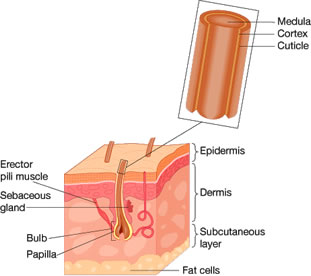Colouring-
What Exactly Is Hair?
Typical mammalian hair consists of the shaft, protruding
above the skin, and the root, which is sunk in a follicle,
or pit, beneath the skin surface. Except for a few growing
cells at the base of the root, the hair is dead tissue
and is composed of keratin and related proteins. The hair
follicle is a tubelike pocket of the epidermis, that encloses
a small section of the dermis at its base. Human hair
is formed by rapid divisions of cells at the base of the
follicle. As the cells are pushed upward from the follicle's
base, they harden and undergo pigmentation. |
 |
The
hair on our scalps and in our eyebrows and eyelashes are different
from other bodily hairs. The hair on our heads grows a healthy
.5 inch per month, and long scalp hairs have an average life
of 3 to 5 years. Most of us have between 100,000 and 150,000
hairs on our heads!
There
are two kinds of melanin found in the hair: eumelanin (the most
common and responsible for hair shades from brown to black)
and phaeomelanin (responsible for yellowish-blond, ginger and
red colors). Absence of pigment produces white/gray hair. Before
any permanent color can be deposited into the hair shaft, the
cuticle , or outer layer, must be opened. The insoluble formula
then reacts with the cortex to deposit or remove the color.
How Do Hair Colouring Products Work?
Smart
Beauty has sourced and utilised advanced formulations using
the finest pharmaceutical grade ingredients to ensure gentle
but consistent high performance.
Part of the collection features a unique, fast and effective
colour formulation with added conditioners that lifts the natural
hair colour by a few shades and at the same time, deposits vibrant
colour in one easy step. The collection is suitable for all
hair types, natural or pre-coloured, even the darkest of shades.
No pre-lightening is necessary.
Here
are basic descriptions.
* Level 1, semi-permanent colour -- This product
adds color without changing natural color dramatically. The
hair color contains tiny color molecules that enter the hair's
cuticle, or outer layer, and go into your hair's cortex. They
don't interact with your natural pigments. And since the molecules
are small, they eventually exit the hair shaft after several
shampoos, leaving the hair as it was before treatment. This
level generally lasts for 6 to 12 shampoos, covers up to 50
percent gray, enhances your natural color and leaves no roots.
This hair coloring won't lighten your hair color because it
contains no ammonia or peroxide.
*
Level 2, demi-permanent colour -- This product level
lasts longer, through 24 to 26 shampoos. In this process, pre-color
molecules penetrate the cuticle and enter the cortex where they
then partner to create medium-sized color molecules. Their larger
size means they take longer to wash out. These products do not
contain ammonia so the natural pigment can't be lightened. However,
it contains a small amount of peroxide, which allows for a subtle,
but noticeable, color enhancement. It also blends and covers
gray. (Both semi- and demi-permanent colors can become permanent
on permed or already-colored hair!)
* Level 3, permanent colour -- This is what
you need for a more significant color change (to go from black
to blond, you'll still need to go with a process called double
process blonding and it'd be wise to get this it done professionally).
In this level, both ammonia and peroxide are used. Tiny molecules
enter all the way into the cortex, where they react and expand
to a size that cannot be washed out. Your hair actually has
to grow out over time. This product acts to lighten the hair's
natural pigment to form a new base and then to add a new permanent
color. The end result is a combination of your natural hair
pigment and the new shade you chose. That means the color may
appear different on you than on someone else using the same
color. (That's why the "strand test" is so important
-- more about that later.) Regular touch-ups of 4 to 6 weeks
are generally needed to eliminate roots -- hair with your natural
color growing at half an inch per month from your scalp.
|


